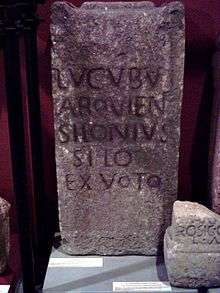Hispano-Celtic languages
Hispano-Celtic is a hypernym to include all varieties of Celtic that were spoken in the Iberian Peninsula before the arrival of the Romans (in c. 218 BC, during the Second Punic War):[3][4]
- a northeastern inland language attested at a relatively late date in the extensive corpus of Celtiberian.[2] This variety, which Jordán Cólera[3] proposed to name northeastern Hispano-Celtic, has long been synonymous with the term Hispano-Celtic and is universally accepted as a Celtic language.
- a language in the northwestern corner of the peninsula, with a northern and western boundary marked by the Atlantic Ocean, a southern boundary along the river Douro, and an eastern boundary marked by Oviedo, which Jordán Cólera has proposed to call northwestern Hispano-Celtic, where there is a corpus of Latin inscriptions containing isolated words and sentences that are clearly Celtic.[5][6]
| Hispano-Celtic | |
|---|---|
| Geographic distribution | Iberian Peninsula |
| Linguistic classification | Indo-European
|
| Subdivisions | |
| Glottolog | (not evaluated) |
| Part of a series on |
| Indo-European topics |
|---|
 |
|
|
Philology
|
|
Origins |
|
Archaeology Pontic Steppe
Caucasus East Asia Eastern Europe Northern Europe Pontic Steppe Northern/Eastern Steppe Europe
South Asia Steppe Europe Caucasus India |
|
Peoples and societies Indo-Aryans Iranians
East Asia Europe East Asia Europe
Indo-Aryan Iranian
|
|
Religion and mythology
Indo-Aryan Iranian Others Europe
|
|

Western Hispano-Celtic is a term that has been proposed for a language continuum of dlalects, ranging from Celtic Gallaecian, Tartessian (according to Koch and others) to Lusitanian,[7] which has sometimes been labelled "para-Celtic", located in the Iberian peninsula west of an imaginary line running north–south linking Oviedo and Mérida.[3][8] According to Koch, the Western Celtic varieties of the Iberian Peninsula share with Celtiberian a sufficient core of distinctive features to justify Hispano-Celtic as a term for a linguistic subfamily, as opposed to a purely-geographical classification.[2]:292 In Naturalis Historia 3.13 (written 77–79 CE), Pliny the Elder stated that the Celtici of Baetica (now western Andalusia) descended from the Celtiberians of Lusitania since they shared common religions, languages and names for their fortified settlements.[9]
As part of the effort to prove the existence of a western Iberian Hispano-Celtic dialect continuum, there have been attempts to differentiate the Vettonian dialect from the neighbouring Lusitanian language using the personal names of the Vettones to describe the following sound changes (Proto-Indo-European to Proto-Celtic):[8]:351
- *ō > ā occurs in Enimarus.
- *ō > ū in final syllables, as indicated by the suffix of Abrunus, Caurunius.
- *ē > ī is attested in the genitive singular Riuei.
- *n̥ > an appears in Argantonius.
- *m̥ > am in names with Amb-.
- *gʷ > b is attested in names such as Bouius, derived from *gʷow- 'cow'.
- *kʷ in PIE *perkʷ-u- 'oak' appears in a lenited form in the name Erguena.
- *p > ɸ > 0 is attested in:
- *perkʷ-u- > ergʷ- in Erguena (see above).
- *plab- > lab- in Laboina.
- *uper- > ur- in Uralus and Urocius.
See also
References
- Meid, W. Celtiberian Inscriptions (1994). Budapest: Archaeolingua Alapítvány.
- Koch, John T. (2010). "Chapter 9: Paradigm Shift? Interpreting Tartessian as Celtic". In Cunliffe, Barry; Koch, John T. (eds.). Celtic from the West: Alternative Perspectives from Archaeology, Genetics, Language and Literature. Celtic Studies Publications. Oxford: Oxbow Books. pp. 292–293. ISBN 978-1-84217-410-4. Reissued in 2012 in softcover as ISBN 978-1-84217-475-3.
- Jordán Cólera, Carlos (16 March 2007). "The Celts in the Iberian Peninsula:Celtiberian" (PDF). e-Keltoi. 6: 749–750. Retrieved 16 June 2010.
- Koch, John T. (2005). Celtic Culture: A Historical Encyclopedia. ABC-CLIO. p. 481. ISBN 978-1-85109-440-0.
- "In the northwest of the Iberian Peninula, and more specifically between the west and north Atlantic coasts and an imaginary line running north-south and linking Oviedo and Merida, there is a corpus of Latin inscriptions with particular characteristics of its own. This corpus contains some linguistic features that are clearly Celtic and others that in our opinion are not Celtic. The former we shall group, for the moment, under the label northwestern Hispano-Celtic. The latter are the same features found in well-documented contemporary inscriptions in the region occupied by the Lusitanians, and therefore belonging to the variety known as LUSITANIAN, or more broadly as GALLO-LUSITANIAN. As we have already said, we do not consider this variety to belong to the Celtic language family." Jordán Cólera, Carlos (March 16, 2007). The Celts in the Iberian Peninsula:Celtiberian (PDF). e-Keltoi 6: 749–750'
- Prósper, Blanca María (2002). Lenguas y religiones prerromanas del occidente de la península ibérica. Ediciones Universidad de Salamanca. pp. 422–427. ISBN 84-7800-818-7.
- Koch, John T. (2009). "Tartessian: Celtic from the South-west at the Dawn of History" (PDF). Acta Palaeohispanica. Zaragosa, Spain: Institución Fernando el Católico. 9: 339–351. ISSN 1578-5386. Retrieved 17 May 2010.. Journal renamed to Palaeohispanica: Revista sobre lenguas y culturas de la Hispania Antigua. This particular work has also been published in book form, and revised: Koch, John T. (2013) [2009]. Tartessian: Celtic from the South-west at the Dawn of History. Celtic Studies. 13 (2nd ed.). Aberystwyth: David Brown Publishing.
- Wodtko, Dagmar S. (2010). "Chapter 11: The Problem of Lusitanian". In Cunliffe, Barry; Koch, John T. (eds.). Celtic from the West: Alternative Perspectives from Archaeology, Genetics, Language and Literature. Celtic Studies Publications. Oxford: Oxbow Books. ISBN 978-1-84217-410-4.:360–361 Reissued in 2012 in softcover as ISBN 978-1-84217-475-3.
- Pliny the Elder. "3.13". Naturalis Historia.
Celticos a Celtiberis ex Lusitania advenisse manifestum est sacris, lingua, oppidorum vocabulis, quae cognominibus in Baetica distinguntur
. Written 77–79 CE. Quoted in Koch (2010), pp. 292–293. The text is also found in online sources: , . - Lujan, E. (2007). Lambert, P.-Y.; Pinault, G.-J. (eds.). "L'onomastique des Vettons: analyse linguistique". Gaulois et celtique continental (in French). Geneva: Librairie Droz.: 245–275.
